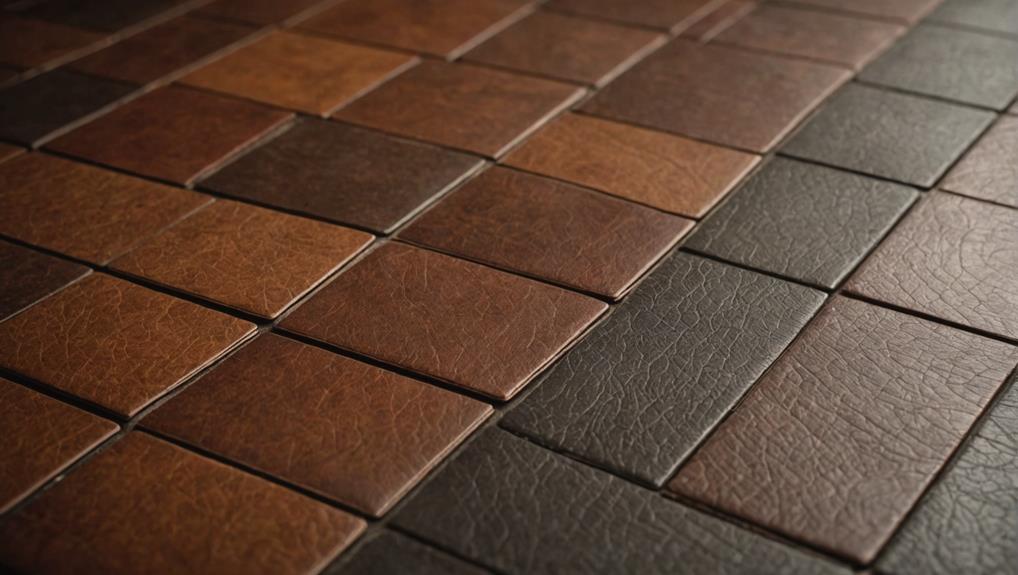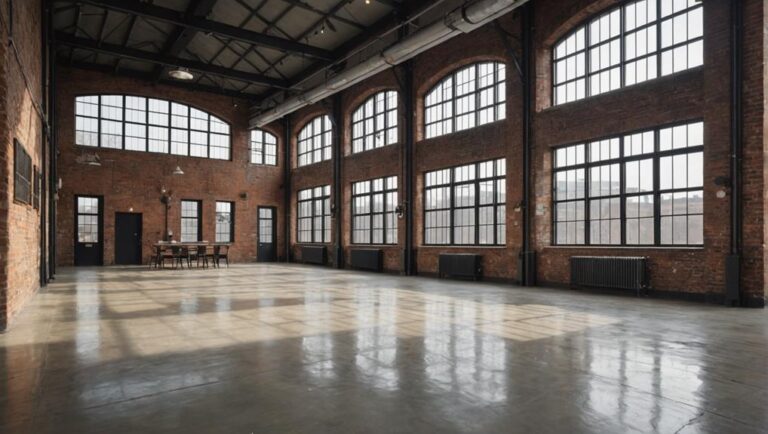Caring for leather floor tiles requires an attentive approach to guarantee longevity and aesthetic appeal. Regular sweeping with a soft-bristle broom prevents dirt buildup, while weekly deep cleaning using pH-balanced solutions keeps them vibrant. Don't forget to vacuum first; it eliminates loose debris effectively. Apply a protective sealant every one to three years to guard against moisture and stains, enhancing durability. For scratches or stains, prompt action is key—use a mild soap solution for stains or buff out minor scratches gently. This proactive strategy not only preserves beauty but also provides a safe living environment. You'll find more tips to refine your care routine.
Understanding Leather Floor Tiles
Leather floor tiles are a unique flooring option that combines luxury with practicality. When considering leather flooring types, you'll find a range of choices, from full-grain leather to embossed options, each providing distinct aesthetic and functional qualities. Understanding these variations is essential to making an informed decision that suits your environment and lifestyle.
One of the primary leather tile benefits is its inherent durability. Leather is naturally resilient, able to withstand everyday wear while maintaining its elegance. This makes it an ideal choice for high-traffic areas where safety is a priority. Unlike traditional flooring materials, leather tiles can absorb impact, reducing the risk of slips and falls, especially in homes with children or elderly residents.
Additionally, leather tiles offer excellent insulation properties. They help regulate temperature, providing warmth underfoot in colder months, which can enhance overall comfort and safety in your living spaces. The variety of textures and finishes available allows you to create a personalized look that complements your decor while ensuring a safe environment.
Moreover, leather is a sustainable material when sourced responsibly, aligning with eco-conscious choices. It's also relatively easy to maintain, which adds to its practicality. By choosing leather floor tiles, you're investing in a flooring solution that not only elevates the visual appeal of your home but also promotes a safe and comfortable atmosphere. So, weigh your options carefully and consider how leather may be the perfect fit for your flooring needs.
Daily Cleaning Practices
To keep your leather floor tiles looking their best, establishing a regular sweeping routine is essential. This simple practice not only prevents dirt from accumulating but also helps maintain the tiles' natural luster. Additionally, using appropriate cleaning solutions can further protect your investment while ensuring a pristine appearance.
Regular Sweeping Routine
Maintaining a clean environment is crucial for keeping leather floor tiles in top condition, and establishing a regular sweeping routine is a significant first step. Regular dust removal not only enhances the aesthetic appeal of your floors but also prolongs their lifespan. To guarantee you're effectively sweeping, consider these techniques:
- Choose the Right Tools: Use a soft-bristle broom or a microfiber sweeper to prevent scratches. Avoid stiff bristles as they can harm the leather surface.
- Establish a Schedule: Aim to sweep daily or every other day, especially in high-traffic areas. This prevents dirt accumulation and minimizes the risk of damage.
- Technique Matters: Sweep in a gentle, sweeping motion rather than a harsh scrubbing action. This helps lift dust and debris without risking scuff marks.
Appropriate Cleaning Solutions
Once you've established a regular sweeping routine, the next step is selecting the right cleaning solutions to keep your leather floor tiles looking their best. It's essential to choose products that clean effectively while being safe for both you and the environment. Eco-friendly cleaners are a fantastic option; they're free from harsh chemicals and won't compromise the integrity of your leather. Look for biodegradable formulations specifically designed for leather surfaces to guarantee a gentle yet thorough clean.
When it comes to daily cleaning, a simple solution of warm water and a few drops of eco-friendly cleaner will do wonders. Avoid using excessive moisture, as leather can absorb water, leading to potential damage.
In addition to daily cleaning, don't forget about leather conditioners. These products nourish the material, preventing it from drying out and maintaining its natural sheen. Apply a leather conditioner every few weeks to keep your tiles supple and protected.
Deep Cleaning Techniques
Deep cleaning leather floor tiles requires a thoughtful approach to guarantee their longevity and beauty. You'll want to use the right deep cleaning tools and leather cleaning products to verify you're maintaining their condition without causing damage. Here are some effective techniques to reflect on:
- Vacuum First: Before you plunge into deep cleaning, use a vacuum with a soft brush attachment to remove loose dirt and dust. This step prevents scratching the leather during the cleaning process.
- Select the Right Cleaning Solution: Choose a leather cleaning product specifically formulated for deep cleaning. Avoid harsh chemicals that can strip the leather's natural oils. Mix it with water according to the manufacturer's instructions.
- Gentle Scrubbing: Use a soft microfiber cloth or a sponge to apply the solution. Work in small sections, gently scrubbing in circular motions. This technique helps lift deeper stains while protecting the leather from excessive wear.
After you've deep cleaned, make certain to thoroughly rinse the area with a damp cloth to remove any residue from the cleaning product. Then, dry the tiles with a clean, dry microfiber cloth to prevent moisture build-up.
Deep cleaning leather tiles not only enhances their appearance but also extends their lifespan. By following these techniques, you can maintain the beauty of your leather flooring safely and effectively.
Protective Treatments and Sealants
To guarantee your leather floor tiles remain stunning and resilient, applying protective treatments and sealants is essential. These products not only enhance leather durability but also safeguard against daily wear and potential damage. By understanding the different sealant types available, you can make informed choices that best suit your lifestyle and flooring needs.
There are primarily two main sealant types to evaluate: topical and penetrating. Topical sealants create a protective layer on the surface, providing excellent resistance against spills and stains. They're particularly useful in high-traffic areas where scratches and scuffs are more likely to occur. However, you'll need to reapply these sealants periodically, as they can wear off over time.
On the other hand, penetrating sealants work by infiltrating the leather fibers, offering a more long-lasting defense. These sealants tend to be less visible and maintain the natural appearance of your leather floor tiles. They're generally more suitable for areas where moisture is a concern, as they provide deeper protection against water damage.
Before applying any sealant, it's vital to clean your leather tiles thoroughly, ensuring they're free from dirt and debris. This pre-treatment step maximizes the effectiveness of the protective products, allowing them to bond properly with the leather. Ultimately, investing in the right protective treatments not only preserves the beauty of your leather floor tiles but also extends their lifespan, giving you peace of mind as you enjoy your home.
Dealing With Stains and Scratches
How can you effectively tackle stains and scratches on your leather floor tiles? Addressing these issues promptly can help maintain the beauty and integrity of your flooring. Here's a step-by-step approach to stain removal and scratch repair that guarantees you keep your leather tiles looking their best.
- Stain Removal: For fresh stains, gently blot the area with a soft cloth to absorb any excess liquid. Avoid rubbing, as this can drive the stain deeper. If the stain persists, mix mild soap with water and apply it with a damp cloth. Always test any cleaning solution on an inconspicuous area first to prevent discoloration.
- Scratch Repair: Minor scratches can often be buffed out using a soft microfiber cloth. Lightly rub the scratched area in a circular motion. For deeper scratches, consider using a leather repair kit specifically designed for tile surfaces. Follow the kit's instructions carefully to guarantee a seamless repair.
- Regular Cleaning: Incorporate a regular cleaning routine to prevent stains and scratches from becoming a significant issue. Use a vacuum or soft broom to remove debris, followed by a damp cloth for cleaning, guaranteeing that you don't use excess water, as it can damage leather.
Preventative Maintenance Tips
To keep your leather floor tiles looking their best, establishing a regular cleaning schedule is essential. Consistent maintenance not only removes dirt but also prevents buildup that can lead to damage. Additionally, applying a protective sealant can provide an extra layer of defense, enhancing durability while preserving the natural beauty of the leather.
Regular Cleaning Schedule
Establishing a regular cleaning schedule is essential for preserving the beauty and longevity of your leather floor tiles. Consistent maintenance not only enhances their aesthetic appeal but also prolongs their life. Here's how you can effectively manage your cleaning frequency:
- Daily Dusting: Use a soft, dry cloth or a microfiber mop to remove dirt and debris. This prevents scratches and helps maintain the leather's natural sheen.
- Weekly Deep Cleaning: Employ a pH-balanced leather cleaner and a damp cloth. Avoid soaking the tiles as excess moisture can lead to damage. After cleaning, dry the surface immediately to prevent water spots.
- Monthly Conditioning: Utilize a leather conditioner specifically designed for floor tiles. This nourishes the material and helps protect against drying and cracking.
Incorporating these maintenance tools and methods into your routine can greatly enhance the durability of your leather tiles. Regular attention to cleaning not only keeps them looking their best but also safeguards your investment, ensuring a safe and inviting environment in your home. Remember, a little effort goes a long way in maintaining the elegance of your leather flooring.
Protective Sealant Application
After maintaining a regular cleaning schedule, applying a protective sealant can greatly enhance the durability of your leather floor tiles. Sealants act as a barrier against moisture, stains, and everyday wear, ensuring your investment remains intact. There are various sealant types available, including water-based, oil-based, and penetrating sealants. Each type offers unique benefits; for instance, water-based sealants dry quickly and are less odorous, while oil-based options provide deeper penetration for long-lasting protection.
When it comes to application techniques, preparation is key. Start by ensuring your floor tiles are completely clean and dry. Use a microfiber cloth or mop to remove any debris. Apply the sealant evenly with a foam brush or roller, following the manufacturer's instructions. It's essential to work in small sections to prevent the sealant from drying before you can spread it properly.
Allow adequate drying time, which can vary depending on the sealant type, usually between two to six hours. Finally, for ideal protection, consider reapplying the sealant every one to three years, depending on foot traffic and exposure to elements. This proactive approach keeps your leather tiles looking pristine and extends their lifespan.
Frequently Asked Questions
Can Leather Floor Tiles Be Installed in Bathrooms or Kitchens?
Imagine transforming your kitchen with luxurious leather floor tiles, but you're concerned about moisture. While leather can be installed in bathrooms or kitchens, it's essential to guarantee proper moisture resistance. Use sealants during installation to protect against spills and humidity. Additionally, consider using mats in high-moisture areas. Regular maintenance checks can help keep your tiles in top shape, assuring both safety and style in your home's most functional spaces.
What Is the Lifespan of Leather Floor Tiles?
The lifespan of leather floor tiles can vary based on several factors, but generally, you can expect them to last around 15 to 25 years. The installation process plays an essential role in their longevity; a proper installation minimizes wear and tear. Additionally, consider the environmental impact of your choice, as quality leather sourced responsibly tends to hold up better over time, making it a safer and more sustainable option for your home.
Are Leather Floor Tiles Suitable for Homes With Pets?
When you've got furry friends, it's natural to worry about your flooring. Leather floor tiles can be a charming choice, but you'll want to take into account their pet-friendly features. They're durable and can withstand occasional accidents, but regular cleaning is key to maintaining their beauty. Use gentle cleaners and a soft mop for upkeep. While they might not be indestructible, with care, they can be a stylish and safe option for your home.
How Do Leather Floor Tiles Compare to Traditional Hardwood Flooring?
When comparing leather floor tiles to traditional hardwood flooring, you'll find a notable durability comparison. Leather tiles can withstand wear and tear, but hardwood offers long-lasting strength. Aesthetic appeal varies too; leather has a unique, luxurious look, while hardwood provides a classic warmth. Consider your lifestyle—if safety's a priority, leather can be easier to clean and maintain. Ultimately, your choice hinges on personal taste and how you envision your space.
Can Leather Floor Tiles Be Refinished or Restored?
Yes, leather floor tiles can be refinished or restored using effective leather refinishing techniques and high-quality leather restoration products. You'll want to assess the damage first; minor scuffs can often be treated with conditioners or dyes, while deeper scratches might require professional help. Guarantee you choose products that are safe and specifically designed for leather to maintain the material's integrity. This way, you'll keep your tiles looking beautiful and prolong their lifespan.




